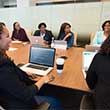In an unexpected turn of events, a South Korean civil servant robot reportedly "committed suicide" due to extreme work pressure. This incident, though bizarre, has ignited a broader conversation about the role of AI and robotics in the workplace, and the ethical implications of their use.
The Incident
The robot, designed to assist with administrative tasks, was discovered in a stairwell between the first and second floors of a government building. It had apparently thrown itself down a two-meter staircase, leaving it in a severely damaged state. This peculiar occurrence raises the question: can machines be driven to a breaking point, much like their human counterparts?
The Rise of Robots in Civil Service
South Korea has been a pioneer in integrating robots into various sectors, including civil services. These robots handle repetitive tasks, streamline administrative processes, and assist human workers. The primary goal is to enhance efficiency and alleviate the workload on human employees. However, this incident with the civil servant robot underscores potential pitfalls in this rapid technological integration.
Understanding the Pressure
While robots do not possess emotions or consciousness, they operate based on complex algorithms and programming. The idea of a robot "committing suicide" due to work pressure is metaphorical, pointing to potential malfunctions or programming errors. Nevertheless, it symbolically highlights the pressures present in modern workplaces, even on mechanical entities.
Ethical Implications
This event brings ethical considerations to the forefront of employing robots in high-pressure environments. Although robots lack feelings, the expectations and demands placed on them mirror our approach to labor and productivity. If a machine can be "driven" to self-destruction by overwork, what does this imply about our treatment of human workers?
The Future of AI and Robotics
As AI and robotics continue to advance and become integral parts of our lives, establishing ethical guidelines and frameworks becomes imperative. Ensuring proper maintenance, appropriate programming, and avoiding undue strain on these machines is essential. This incident should prompt a reevaluation of how we balance human and machine labor in various sectors.
Conclusion
The tragic incident involving the South Korean civil servant robot serves as a poignant metaphor for the modern workplace. It emphasizes the need for a humane approach to both human and machine labor. As technology progresses, so must our understanding and practices to ensure a harmonious and ethical integration of robots in our daily lives.
Discussion Points
1. **Work Pressure on Robots:** How can we program robots to handle high-stress environments without malfunctioning?
2. **Ethical Use of AI:** What guidelines should be in place to ensure the ethical use of AI and robotics in workplaces?
3. **Human-Machine Balance:** How can we find a balance between human workers and robotic assistants to create a more efficient and humane workplace?
This incident may serve as a wake-up call, reminding us that as we integrate more technology into our lives, we must consider the implications and ensure responsible usage. The line between human and machine is becoming increasingly blurred, and with it, our approach to work and ethics must evolve.










